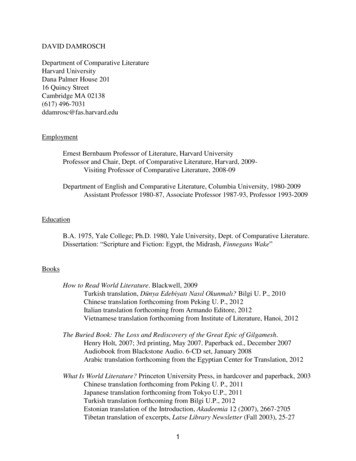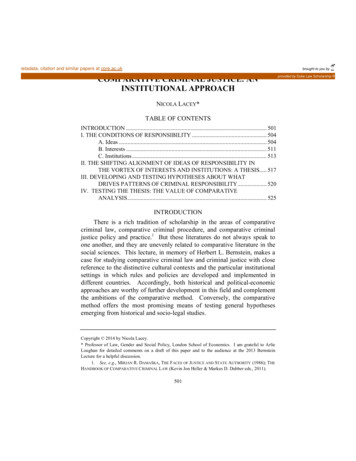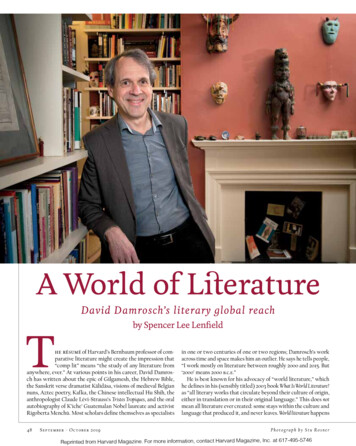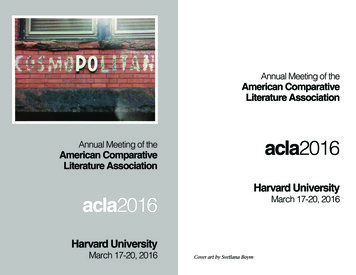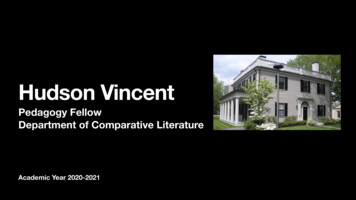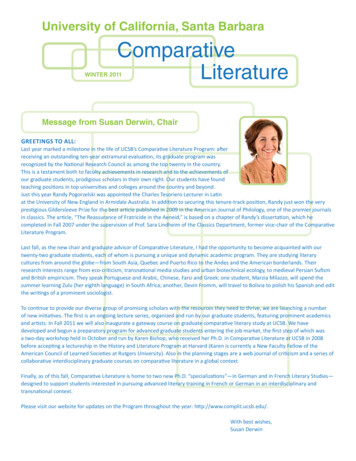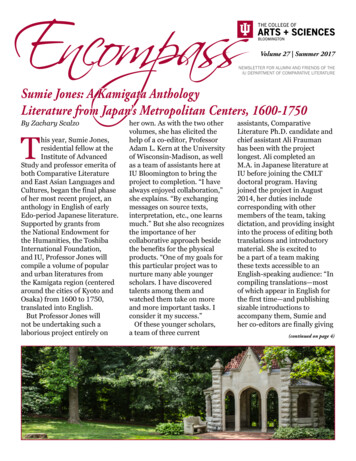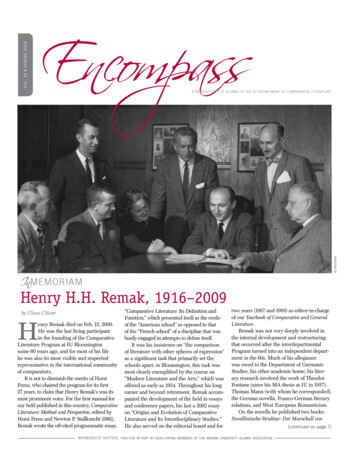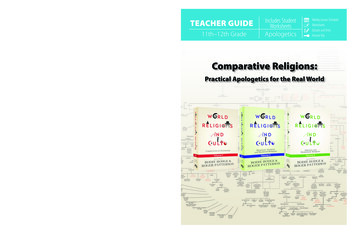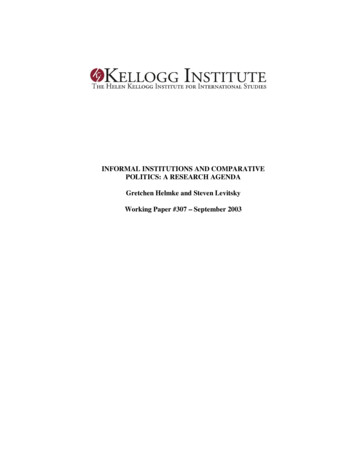
Transcription
ISSN 2469-4576 (Print)E-ISSN 2469-4584 (Online)Volume 6, Number 2, 2021Comparative Literature &World Literaturewww.cwliterature.org
Comparative Literature&Journal DescriptionIn the form of print as well as online with open-access,Comparative Literature & World Literature (CLWL) isa peer-reviewed, full-text, quarterly academic journal inthe field of comparative literature and world literature,whose purpose is to make available in a timelyfashion the multi-faceted aspects of the discipline. Itpublishes articles and book reviews, featuring thosethat explore disciplinary theories, comparative poetics,world literature and translation studies with particularemphasis on the dialogues of poetics and literatures inthe context of globalization.Subscription RatesIndividual subscription: 40/per yearStudent subscription: 20/per year (A copy of a validstudent ID is required)SponsorsSchool of Chinese Language and Literature, BeijingNormal University (P. R. China)The College of Humanities, the University of Arizona,Tucson (USA)World LiteratureAll rights reservedThe right to reproduce scholarship published in thejournal Comparative Literature & World Literature(ISSN 2469-4576 Print ; ISSN 2469-4584 Online )is governed by both Chinese and US-Americancopyright laws. No part of this publication may bereproduced, in any form or by any means, electronic,photocopy, or otherwise, without permission in writingfrom School of Chinese Language and Literature,Beijing Normal University and College of Humanities,the University of Arizona.Editorial OfficeAddress: Comparative Literature & World Literatureeditorial office, School of Chinese Language andLiterature, Beijing Normal University, No. 19Xinjiekouwai Street, Beijing, 100875, P. R. China.Email: edu
Comparative Literature & World LiteratureVolume 6, Number 2, 2021Editors in Chief (2016- )Cao, Shunqing 曹顺庆 Beijing Normal University (China) shunqingcao@163.com Liu, Hongtao 刘洪涛Beijing Normal University (China) htliu@bnu.edu.cn Associate Editors (2017- )Li, Dian 李点The University of Arizona (USA)Liu, Qian 刘倩The University of Warwick (UK)Advisory BoardBassnett, SusanThe University of Warwick (UK)Bertens, HansUrtecht University (Netherlands)Yue, Daiyun 乐黛云Peking University (China)Editorial BoardBeebee, O. ThomasThe Pennsylvania State University (USA)Chen, Guangxing 陈广兴 Shanghai International Studies University (China)Damrosch, DavidHarvard University (USA)Dasgupta, Subha ChakrabortyJadavpur University (India)D’haen, TheoUniversity of Leuven (Belgium)Fang, Weigui 方维规Beijing Normal University (China)Wang, Ning 王宁Tsinghua University (China)Yang, Huilin 杨慧林Renmin University (China)Yao, Jianbin 姚建彬Beijing Normal University (China)Luo, Liang 罗靓University of Kentucky (USA)Assistant EditorsWang, Miaomiao 王苗苗Chang, Liang 常亮North China Electric Power University Hebei Normal University for NationalitiesShi, Guang 时光Beijing Foreign Studies UniversityChen, Xin 陈鑫Beijing Normal UniversityAzuaje-Alamo, Manuel 柳慕真Harvard UniversityMoore, Aaron Lee 莫俊伦Sichuan University
CONTENTSArticles1 Constructing “Superstitious Myth(s)”: The TransculturalPractice of Mythological Knowledge in China from the1920s to the 1930s/Mingchen Yang (Beijing Normal University)31 Queer Match of Literary Icons: Curtains up for Ma Liang’s“Pig-head Lover” of the “Book of Taboo” Series/Eva Aggeklint (independent scholar)61 An Account of the Empire of China and the SinologicalThoughts of the Dominican Domingo Fernández deNavarrete/Yiying Zhang (Beijing Normal University)Book Reviews80 Flair Donglai Shi and Gareth Guangming Tan, eds. WorldLiterature in Motion: Institution, Recognition, Location.Stuttgart: ibidem-Verlag. 2020. IBSN 9783838211633. 532 pp./Teh Tian Jing (Beijing Normal University)86 Liu Hongtao. Xu Zhimo and the University of Cambridge.Beijing: The Commercial Press. 2011. ISBN 9787100083737.262 pp./Zhang Yuqing (University of Warwick)90 Stuart Lyons. Xu Zhimo in Cambridge: Life and Poetry.Cambridge: King’s College. 2021. ISBN 9781527292314.334 pp./Zhang Yuqing (University of Warwick)94 Eugene Chen Eoyang. The Transparent Eye: Reflectionson Translation, Chinese Literature, and ComparativePoetics. Honolulu: University of Hawai’i Press. 1993.ISBN 9780824814298. 311pp./Ma Huanhuan (Beijing Normal University)Volume 6, Number 2, 2021
ArticlesConstructing “Superstitious Myth(s)”:The Transcultural Practice of MythologicalKnowledge in China from the 1920s tothe 1930sMingchen Yang(Beijing Normal University)Abstract:This paper traces the origin of modern China’s conception of myth assuperstition by addressing the transcultural practice of mythological knowledgein 1920s-1930s China. In the 1920s, Chinese intellectuals devoted to folklorestudies constructed a body of knowledge related to myth and superstition throughappropriating Western and Japanese modern scholarship. They borrowed themethodology and ideas of textual research on myth from the West and Japan butfurther developed their original interpretation by equating mythical belief withsuperstition. This transformation of knowledge made myth into the target of antisuperstition movements in modern China and even laid the foundation for thepolitical regulation of literature and arts (especially in traditional Chinese opera)featuring magical content that was initiated by the Nanjing KMT government.The transcultural practice revealed in this research made us reconsider thesuppressed mythical and supernatural experience in modern Chinese thought andliterature.Keywords: superstitious myth(s), transcultural practice, literary and artisticgovernanceVolume 6, Number 2, 20211
IntroductionIn China during the early 1950s lasting and influential debates on literaryexpressions of myth and superstition took place, and these involved famous writersand artists such as Tian Han 田汉, Zhou Yang 周扬, Huang Zhigang 黄芝冈, andMa Shaobo 马少波. The essential question of these debates lay in how to deal withthe supernatural content present in literature and the arts (especially in traditionalChinese operas) in order to create anti-superstition new works. Most maintainedthat myth should be distinguished from superstition; however, they were alsoclearly aware of the difficulty in properly defining and tackling the magical elementand transcendental beliefs embodied in myth.1 The issues put forward in thesedebates were fundamental in shaping the contemporary Chinese literary and artisticexperience. Myths that made references to the story of gods with supernatural andreligious beliefs were inevitably questioned from a modern scientific discourse andin turn became entangled with the concept of superstition.The debates and topics above were so important that they have drawn attentionfrom current scholars. Most studies put them in the framework of socialistideological structure in order to regard them as a cultural practice exclusive to PRCculture after 1949.2 My paper intends to intervene in the discussion of mythical122For debates on myth and superstition in literature and the arts, see Tian Han. “Fight for thePeople’s New Opera of Patriotism” (Wei aiguozhuyi de renmin xin xiqu er fendou 为爱国主义的人民新戏曲而奋斗), People’s Daily 人民日报, January 21st, 1951, 5th edition;Zhou Yang. “Reform and Development of National Opera Arts” (Gaige he fazhan minzuxiqu yishu 改革和发展民族戏曲艺术), Journal of Literature and Art 文艺报, (24) 1952;Ma Shaobo 马少波. “The Essential Difference Between Superstition and Myth” (Mixin yushenhua de benzhi qubie 迷信与神话的本质区别), Reference Materials On Opera Reform,Volume 2 (Xiqu gaige lunji 戏曲改革论集), pp. 46-49; Huang Zhigang 黄芝冈. “On‘Mythological Operas’ and ‘Superstitious Operas” (Lun “Shenhuaju” yu “Mixinxi” 论“神话剧”与“迷信戏”), Huang Zhigang. From Yangko to Local Operas (Cong yangge daodifangxi 从秧歌到地方戏), Shanghai: Zhonghua Book Company, 1951, pp. 51-71.The representative research focused on the reform of ghost operas in the PRC includesworks such as Zhang Lianhong张炼红. Cultivation of the Soul: Research on the Reform ofChinese Traditional Operas in the People’s Republic of China (Lilian jinghun: Xinzhongguoxiqu gaizao kaolun 历炼精魂:新中国戏曲改造考论), Shanghai: Shanghai People’sPublishing House, 2013; Wang Ying王英. “The Nation without Ghosts: Debates on theGhostly Operas in the CCP Party and Province of Shaanxi (1949-1966) ” (Wugui zhi guo:Zhonggong yu Shaanxi diqu de “Guixi” zhi zheng �之争), The Journal of Twenty-First Century, December 2016, pp. 51-66; Margaret CarolineGreene. “The Sound of Ghosts: Ghost Opera, Reformed Drama, and the Staging of A NewChina, 1949-1979”, UC San Diego Electronic Theses and Dissertations, 2013.Comparative Literature & World Literature
and superstitious experience entangled in modern Chinese cultural and literarypractice, but contrary to the mainstream discourse and perspective, I take this 1950shistorical event as a sequel and echo of earlier Chinese anti-superstition discoursesdating back to the 1920s and 1930s, when traditional Chinese myths clearly becamethe target of anti-superstition enlightenment movements and were criticized bymodern intellectuals and the KMT government. Some academic intellectuals atthat time, especially those who studied folklore, established systematic knowledgeof myth to support or even construct anti-superstition discourse. They appropriatedthe research methodology Western and Japanese scholars developed from the late19th to early 20th centuries in order to deconstruct mythical belief and look downon folk magic as superstition. Their knowledge affected the political governance ofsocial customs initiated by the Nanjing KMT government, which took measures toban performances involving deities and ghosts.The historical perspective leads my paper to center on the period from the1920s to 1930s in China, when the epistemic framework of “superstitious myth(s)”was constructed and the political governance of mythical literature and artsdeveloped. In terms of the specific research objects and scope, my paper focuseson the academic practice of modern Chinese folklore scholars in the late 1920s andthe KMT governmental regulation of traditional operas around the same time. Theacademic knowledge of myths was converted into political discourse at the level ofthe KMT government’s cultural governance. In this sense, this research emphasizestwo signs of interaction: on the one hand, there was transcultural interaction amongthe West, Japan, and China that produced the knowledge of “superstitious myth(s)”;on the other hand, the new knowledge that was formed from transcultural contactinteracted with the political practice conducted by state authority in China. Bycombining the two signs, my paper goes beyond common influence studies orparallel studies and combines various flexible transcultural connections and trends.China’s modern conception of myth was not only constructed in cross-culturalideas but also spanned and crossed multiple boundaries, such as knowledge/politics,scholarly research/social practice, and cultural thought/literary experience. Thistranscultural study leads my research to depict a contact “site” or “zone,” in whichvarious elements, including knowledge, thoughts, literature and politics fromVolume 6, Number 2, 20213
different nations, collided, merged and transformed.3 The concept of contact sitesor contact zones inspired this research to break out of the linear and simplifiedrelationship of “influence/acceptance” between China and the world by revealingmore complex connections and practices.1. Background: Faces of Mythological Conception in Modern ChinaChina’s perception of myth was inseparable from contact with Westernanthropological and ethnographic knowledge since the first emergence of theconcept of Shenhua (Myth 神话) in the late Qing Dynasty. Liang Qichao 梁启超 first used the Chinese word for myth (Liu 19) and mentioned the term “Greekmythology” in his article “Relationship Between History and Race” (Lishi yurenzhong zhi guanxi 历史与人种之关系) published in Xin Min Cong Bao 新民丛报in 1902: “The Semite was the source of the world religions, from which Judaism,Christianity and Islam originated. The Ancient Greek myths and the names ofgods and their sacrifices all came from Assyria and Phoenicia.” (Liang 21) Here,Liang showed awareness that the myths were about names and stories of gods asthe products of religion. He talked about the origin, evolution and distribution ofWestern myths and related the mythical phenomenon to races of the world. Liang’sunderstanding demonstrated the thinking pattern of comparative mythologicalstudy popular in Europe since the 19th century. Comparative mythology aimed toredraw the evolutionary history of human civilization by investigating the originand evolution of myth around the world, which closely overlapped with moderndisciplines of anthropology, archeology, geology, and ethnography.Like many contemporary Chinese intellectuals, Liang Qichao was exposed toWestern knowledge and ideas through Japan, which acted as an intermediary, andin fact, the modern Chinese word for myth was also derived from modern Japanesekanji. During the same period, the terms “myth” and “comparative mythology”clearly appeared in popular Japanese works History of Chinese Civilization byShirakawa Jiro 白河次郎 (Shirakawa 8) and History of World Civilization byTakayama Jiro 高山林次郎 (Takayama 21) , and these two books were translatedand published in China in 1903. Shirakawa and Takayama introduced myth andmythology by redrawing the origin, distribution and blood relationship of races,a method that was inherited and displayed in Liang Qichao’s article. These two34The concept of contact site or zone is borrowed from Mary Louise Pratt’s Imperial Eyes:Travel Writing and Transculturation. In this book, Pratt used “contact zone” to describecultural contacts and translations from different cultural regions in the context of imperialismand colonialism .Comparative Literature & World Literature
Japanese scholars referred to the prevailing framework of the history of humancivilization that labeled human history and the world under the dichotomy ofbarbarism or civilization, a presented advancement through a linear and hierarchicaltheory of evolution theory, something which represented anthropological andethnographic discourse popular in the late 19th century in Europe (Shirakawa 1-27;Takayama 11-131).Modern knowledge of anthropology, ethnography and comparative mythologyprimarily influenced Chinese intellectuals in regard to how to understand themeaning of myth in the late Qing dynasty and the early Republican China. Theytended to define myth as the product of magic belief at a primitive stage of humanhistory within the perspective of civilizational evolution. However, myth was notbelittled by most Chinese intellectuals for being the opposite of “civilization,” andin contrast, it was always regarded as a useful resource in order to renew Chineseculture and national identity owing to its essentialist character. For example, LiangQichao’s peer Jiang Guanyun 蒋观云 deemed that myth had the value of the genius’imagination and the power of inspiring a people’s ambition, although he wasconscious that it was looked down upon by the intelligentsia in 1903 (Guanyun 1819). Jiang’s idea was echoed in Lu Xun’s 魯迅 famous 1908 article “Break Throughthe Voices of Evil” (Po e’sheng lun 破恶声论), in which Lu Xun spoke highly ofmyths created by primitive societies and regarded them as a demonstration ofmagnificent spirits and human nature (Lu 35-36). Jiang Guanyun and Lu Xun didnot intend to develop a systematic and academic discourse on myth but integratedthe ideas of myth popular in modern European and Japanese disciplines intoChina’s enterprise of cultural enlightenment. For cultural reformers, the academicdiscourses on primitive myth were their narrative resources in building newnational spirits.The 1920s represented an obvious turning point as Chinese intellectuals pavedthe way for the acceptance of mythological knowledge, which was manifestedmainly in two aspects. First, academic writings imitating or adapting European andAmerican mythological and anthropological studies gradually began appearing inChina beginning in the 1920s. For an increasing number of Chinese intellectuals,myth became the object of research and not merely a source of cultural ideas. MaoDun 茅盾, Xie Liuyi 谢六逸, Lin Huixiang 林惠祥, Huang Shi 黃石, Zhao Jingshen赵景深, Zheng Zhenduo 郑振铎, amongst others, were all representative scholarswho made achievements in mythological studies in the span of the 1920s and 1930s.They followed different Western scholars and developed different interpretationsof myth, but most of them were inherited from the British and American schoolsVolume 6, Number 2, 20215
of cultural anthropology and traced the historical evolution of human civilizationand took myth to be a “survival”, an element of the primitive.4 Second, andrelated to the previous point, these scholars emphasized the irrational and barbarictraits of myth when they adopted the academic system of British and Americancultural anthropology.5 Compared with the cultural enlightenment intellectualswho preached the power of myth in the late Qing Dynasty and early Republic,the scholars above subscribed more to the view of cultural hierarchy confirmed inWestern evolutionary theory. In this context, the “backward” and “savage” mythgradually merged into the concept of superstition.The claim that clearly articulated that both myth and legend should beconsidered superstition came from a group of folklore researchers at Sun Yat-senUniversity in the late 1920s. The term “folklore” was originally established by theBritish scholar W.J. Thoms in the mid-19th century and was later developed asa subject, the research objects and methodology of which were closely related tocultural anthropology. Folklore was introduced to China around the 1920s and wasmainly led by Zhou Zuoren 周作人, Gu Jiegang 顾颉刚, Zhong Jingwen 钟敬文,Chang Hui 常惠, Rong Zhaozu 容肇祖 and others at Peking University. After theNorthern Expedition in 1926, a number of scholars at Peking University went southto Sun Yat-sen University in order to rebuild the subject of folklore.6 Rong Zhaozu’sbook Superstition and Legend (Mixin yu chuanshuo 迷信与传说) was amongstone of the most typical works in the folklorist group to insist that myth and legendwere superstition. When Superstition and Legend was published in 1929, Rong wasactively taking part in the construction of folklore studies in Guangzhou, and hisbook belonged to the “Folklore Society Series” (Minsuxuehui congshu 民俗学会丛书) at Sun Yat-sen University. The work was a compilation of articles written4566The theory of survivals was originally put forward by the British anthropologist E.B. Tylor.In his book The Primitive Culture, Tylor pointed out that some ancient customs lost theirutility and integrated rituals but partly continued in modern society. He claimed thesecontinuing customs as survivals. Tylor’s theory of survivals was based on the framework oflinear evolutionism and the division of the civilized stage and the primitive stage of humanhistory.For example, Huang Shi.Mythological Studies (Shenhua yanjiu神话研究), KaimingBookstore, 1927, pp.2-9; Xie Liuyi 谢六逸. Mythology ABC (Shenhuaxue ABC神话学ABC), The World Publishing Company, 1928, pp.32-59; Lin Huixiang. Mythology (Shenhualun 神话论), The Commercial Press,1933, pp.1-20.On the construction of Chinese modern folklore, see Shi Aidong 施爱东. Initiatives forCreating a New Discipline: Advocacy, Management, and Decline of Modern ChineseFolkloristics (Changli yimen xinxueke: Zhongguo xiandai Minsuxue de guchui, jingyinghe zhongluo �吹、经营和中落), Beijing: ChinaSocial Science Press, 2011.Comparative Literature & World Literature
in different periods, but the title of ”superstition and legend” demonstrated thegeneral theme of the author’s discussion. In Superstition and Legend, Rong definedfolk legends as superstition in a clear manner. He declared that the purpose of hiswriting was to break mythical superstitions through professional research: “Weshould study folklore when facing various bodies of knowledge, and we shouldfocus more on the study of superstitions in folklore. Specifically, we should payattention to Chinese superstition because of the convenience of materials.” (Rong 3)This “convenience of materials” urged Rong Zhaozu to turn his eyes to myth andlegend recorded in classical Chinese and folk literature. As far as he was concerned,his duty was to break the superstitious elements contained in Chinese myth andcontribute to modern China’s anti-superstition enterprise.Why did Rong Zhaozu take myth and legend as superstition? How did heachieve the goals of breaking mythical superstition via academic research? Rong’sarticle “Analysis of Legends” (Chuanshuo de fenxi 传说的分析) in the book clearlyrevealed his understanding. He wrote as follows:After myth and legend formed, people would take the attached meaningin growth and evolution as the origin of things. If you denied him, he wouldask you in turn, ‘Why did it exist, exactly?’ If you could not answer him,you failed to break his superstitious belief, and people would insist that theattached meaning was hard evidence. (Rong 139)The paragraph above actually exposed two meanings in Rong’s understandingof myth and superstition. First, in his opinion, it was due to superstition that peoplebelieved in “attached meanings” in the formation of myth and legend. The attachedmeanings he mentioned particularly referred to the stories of gods and miracles thatgradually appeared in the circulation and growth of stories. Rong criticized thatmost people were so convinced of the supernatural figures and magic conveyedin myth that they were not aware that the objects they worshiped were fictitiousand accrued throughout generations. Second, Rong Zhaozu pointed out the way tobreak free from the mythical superstition popular with the people. He claimed toexpose the origins and evolution of myth and legend to people in order to debunkthe sacred gods in stories. He proposed in the preface of his book that intellectualsshould “seek gods’ sources and histories, and honestly describe their original andtrue faces.” (Rong 2) Here, Rong emphasized the responsibility of scholars andhoped that academic practices would play crucial roles in anti-superstition politicaland cultural movements.Volume 6, Number 2, 20217
Rong Zhaozu’s perception of mythical superstition was once representative andprevailing in folklore studies. Like Rong, a majority of folklore scholars consciouslyresorted to modern research methods as the way to debunk mythical superstition.7Here, we should not take the modern academic practice conducted by Chineseintellectuals merely as their weapon of choice to eliminate existing mythicalsuperstitions, but more as the fundamental way to construct the meaning of mythand superstition in modern China. In other words, the modern methodology thatfolklore intellectuals adopted led them to regard myth as superstition and to destroythe mythical belief which was popular amidst the people.Chinese intellectuals’ construction of mythological knowledge was notcompletely invented by themselves but was the product of transcultural contact withthe West and Japan in the 1920s. Chinese scholars, including Rong Zhaozu, locallyappropriated the modern philology approach established in European and Americandisciplines. Some of them had direct exposure to Western knowledge, and someused Japan as an intermediary. In this atmosphere, deconstructing supernaturalmiracles in myth based on textual research that connected Western and East Asianscholarship became a global trend. This transcultural practice urged China toconstruct a significant conception of the myth and anti-superstition discourses. Thenext section of this paper elaborates on the transcultural experience in the China ofthe 1920s.2. Evidential Research in the Transcultural Context: The Construction ofMythological and Superstitious Knowledge in Modern ChinaAs mentioned in the previous section, Rong Zhaozu claimed to “describethe original and true faces of gods in various myths and legends” via academicresearch. Specifically, he resorted to the method of evidential research (kaozheng 考证) to analyze texts recording myth and legend, in the process of which he revealedthe historical evolution of gods and miracles to tell people how they were fabricatedand added in throughout generations.Take Rong Zhaozu’s article “Evidential Research of the God of Erlang” (Erlangshen kao 二郎神考) as an example. Rong compiled various ancient Chinese recordson the God of Erlang and traced the historical development of how the image of thegod was formed. Based on textual research, he asserted that the archetype of theGod of Erlang was the historical figure named Li Bing 李冰, the guardian of Shu (ShuShou 蜀守), originally recorded in The Historical Records (Shi Ji 史记) and Books78The scholars will be discussed in Section 2.Comparative Literature & World Literature
of the Later Han Dynasty (Houhan Shu 后汉书). Over time, there were differentmyths and legends about Li Bing killing the god of the river before the Southernand Northern Dynasties, which began to mold Li Bing into a god (Rong 141-171).It was Rong’s own opinion that the God of Erlang could be traced to the historicalrecords of Li Bing, which contradicted other scholars’ related research. For instance,Hu Shi 胡适 disagreed with Rong’s conclusion and advocated that the historicalfigure Yang Ji 杨戢 was the prototype of the God of Erlang (Hu Correspondence32-33). Although Hu Shi and Rong Zhaozu did not reach an agreement on anyspecific conclusion, the methodology of textual research and the intention to revealthe historical origin of the Erlang God were common points for them. Both of themattempted to deconstruct the sacredness of the god Erlang that was worshipped bythe people.The method of evidential research or textual research practiced by RongZhaozu and Hu Shi was widely popular amongst folklore scholars centered aroundSun Yat-Sen University in the late 1920s. They regarded the research methodologyas an effective way to construct anti-superstition discourse. Rong Zhaozu’s practicecompletely followed Gu Jiegang, who was the central researcher and organizer inthe subject of folklore at that time. Rong had studied under Gu at Peking Universitybefore he engaged in folklore research at Sun Yat-sen University.As Rong Zhaozu’s teacher, Gu Jiegang showed a more prominent tendencyfor historical textual research since he published in 1924 his famous article“The Transformation of the Story of Lady Meng Jiang” (Mengjiangnv gushi dezhuanbian 孟姜女故事的转变) in The Ballad Weekly (Geyao zhoukan 歌谣周刊). This publication was a sensation in folklore academia and encouraged Gu tocontinue a series of studies on the historical legends of Lady Meng Jiang in thenext few years, which were finally compiled as Lady Meng Jiang Story ResearchCollection (Mengjiangnv gushi yanjiuji 孟姜女故事研究集) and published as oneof the Folklore Society’s book series of Sun Yat-sen University. In the study of LadyMeng Jiang legends, Gu Jiegang quoted extensive materials and a solid body ofliterary knowledge in order to verify how the legendary figure of Lady Meng Jiangoriginated from Qiliang’s 杞梁 wife recorded in the Chronicle of Zuo (Zuo zhuan 左传) (Gu Mengjiang 1). He emphasized that the historical evolution and geographicalspread of the historical figure’s story promoted the formation of the transcendentalmyth and the custom of worship in the Lady Meng Jiang Temple. Gu Jiegangdenied the essential existence of the folk goddess of Lady Meng Jiang by tracingher origin and evolution, which achieved a similar purpose of debunking mythicalsuperstitions, just as Rong Zhaozu clearly advocated later.Volume 6, Number 2, 20219
Gu Jiegang’s research on mythology and legend had a great impact, especiallyafter he went to Sun Yat-sen University. He made use of the periodical FolkloreWeekly (Minsu zhoukan 民俗周刊) , founded in 1928, in order to inspire numerouscolleagues to follow him. Beyond those by Rong Zhaozu, many other articlesimitating Gu Jiegang’s research style appeared in Folklore Weekly. For example,the article titled “Textual Research of Fujian Three Gods” (Fujian sanshen kao福建三神考) by Wei Yinglin 魏应麟 was a distinguished achievement amongcontemporaneous articles, and it was also compiled into a monograph and includedin the book series of the Folklore Society together with Gu Jiegang’s and RongZhaozu’s books. In his book, Wei performed textual research on the mythicalfigures of Lady Linshui 临水夫人, King Guo Sheng 郭胜王, and the Queen ofHeaven 天后, who all originated in the Five Dynasties in Fujian (Wei 1-3). Heemphasized the imaginary and fictitious components that were added to themythical gods through multiple generations by analyzing historical documents. Forexample, Wei collected ancient records and folk stories to compare Lady Linshui’sdifferent names, birthdates, birthplaces, ties of consanguinity and life legendsfound across different materials in order to reveal how the goddess was constructedthroughout generations (Wei 6-26). This demonstration of historical evolution wasconsistent with Rong’s research of the God of Erlang and Gu’s research of LadyMeng Jiang.Jiang Shaoyuan 江绍原 was another noteworthy intellectual working at SunYat-sen University in the late 1920s. Differing from most scholars, who consciouslyfollowed Gu Jiegang’s scholarly advocation, Jiang had no direct association withGu or the scholarly subject of folklore, but worked in the study of English; however,he went on to have abundant achievements in folklore and mythological studies.He began to publish articles on Chinese rituals and customs in modern Chinesejournals, including Yu Si 语丝, Morning Supplement 晨报副刊, Meng Jin 猛进,New Women 新女性, Literature Weekly 文学周报, and others, since he went to theUniversity of Chicago t
Azuaje-Alamo, Manuel 柳慕真 Harvard University . Comparative Literature & World Literature Volume 6, Number 2, 2021. CONTENTS Volume 6, Number 2, 2021 Articles 1 Constructing "Superstitious Myth(s)": The Transcultural Practice of Mythological Knowledge in China from the 1920s to the 1930s /Mingchen Yang (Beijing Normal University)
